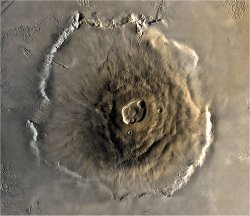
February Editorial
Are there Martians under Olympus Mons?

February Editorial
Are there Martians under Olympus Mons?
|
|
Olympus Mons is the tallest known volcano and mountain in the Solar System. Three times higher than Mount Everest, it is 23 km in height and about 600 km wide. This giant of a mountain is located in a mountain area known as the 'Tharsis bulge' on Mars. Olympus Mons (from Mount Olympus in Latin) has been known to astronomers since the 19th century although in those days it was referred to as an albedo feature (albedo features are large areas on the surface of a planet which are brighter or darker than adjacent areas.). Olympus Mons is a shield volcano with a somewhat lopsided structure, being elongated to the northwest and shortened to the southeast. Though high it is not very steep - the average slope of Olympus Mons is very gradual and long. The reasons why Olympus Mons has its particular shape are not fully understood; and recent a study by Professors Patrick McGovern and Julia Morgan have addressed this very question. The scientists used an algorithm-based computer modelling system known as the particle dynamics model of growing, spreading volcanoes. The intention was to demonstrate that the flank structures on Olympus Mons might reflect the properties of the 'basement' materials underlying the volcano. Based on their results, the scients argue that this basement materia is built from sediments which were transported and accumulated mainly downslope from the Tharsis rise. These sediments, the authors speculate, are likely to correspond to ancient phyllosilicates (clays). This hyopothesis is supported by the fact that the European Space Agency's Mars Express spacecraft has in recent years found abundant evidence of clay on Mars. In their computer model, Morgan and McGovern showed that volcanic material was able to grow to Olympus-sized proportions because of the clay's friction-reducing effect, a phenomenon also seen with volcanoes in Hawaii.All this data supports the theory that where Olympus Mons now stands, a layer of sediment once existed that may have been hundreds of meters thick. But the authors of this research - published recently in Geology - go further and speculate that the presence of sediments indicates that water was or is also involved. Indeed, last year NASA's Phoenix lander, which scratched the surface and found ice underneath the red dust, has produced clear evidence that the water exists on Mars. Is it therefore reasonable to speculate that deep underneath the Olympus Mons there is still a reservoir of liquid clay? Professors Patrick McGovern and Julia Morgan think that this is indeed the case. They go further to say 'This deep reservoir, warmed by geothermal gradients and magmatic heat and protected from adverse surface conditions, would be a favored environment for the development and maintenance of thermophilic organisms' - i.e. life. This final statement is still wild speculation. But when we look closer to home, near geothermal vents deep in Earth's oceans, primal life forms are known to thrive. McGovern, Patrick J., Morgan, Julia K. Volcanic spreading and lateral variations in the structure of Olympus Mons, Mars. Geology, 2009; 37 (2): 139 |
| _______________________________ | ||||
| Home | | | Shopping | | | Database |
© Biscuit Software 2004-2015
All rights reserved